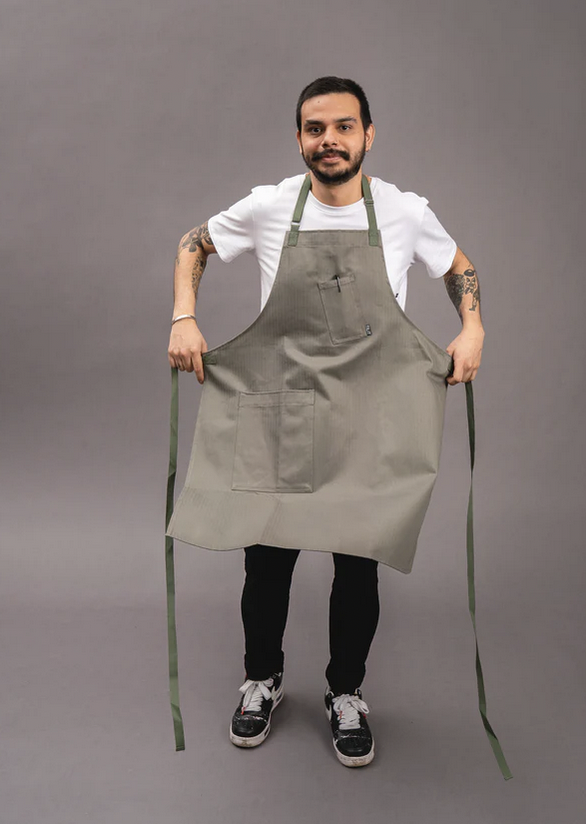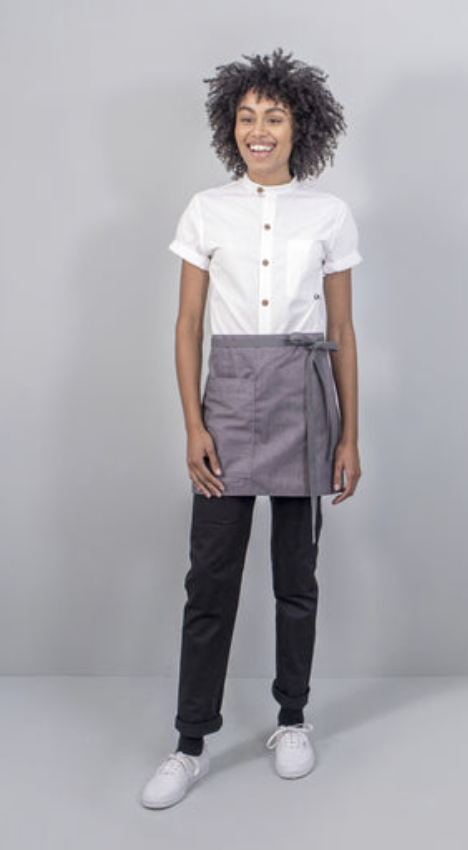Kitchen Essential: Your Culinary Fashion Statement
By Chef David
The item of clothing most often associated with cooking is the apron. Aprons provide protection from spills and splashes. They are not intended to be a rag replacement, used for hand wiping, or mopping up spills, both of which would create cross-contamination by spreading dirt and germs. Most chefs keep a kitchen rag in their apron pocket for that purpose.
Aprons come in all colors, materials, and sizes. The apron may be the most iconic kitchen apparel, a sign of distinction in the kitchen, and a practical consideration – how do you know which one is right for you?
Real Men Wear Aprons
When you think about aprons, does the image of a 1950s housewife come to mind? Aprons accessorized outfits, signifying a domestic focus, but these aprons were more a fashion statement than a protective layer. As women entered the workforce, they shunned the image of being relegated to the home, and aprons fell out of fashion.
The pandemic changed the work dynamics. As people returned to the kitchen, cooking became a popular hobby for both men and women. Aprons gained popularity as practical protection from spills with pockets for convenient storage. They became a sign of expertise for both home chefs and professionals.
What to Consider
When selecting an apron find the style that works best for your body type, it should leave your hands free, be of the proper weight and fit snugly.
Concerned with proper hygiene? Wearing an apron creates a physical barrier that prevents dirt and germs from transferring from your clothing and ending up in your food. For the same reason, be careful to keep your apron clean by washing it frequently.
There are more types of aprons than you may imagine, with modifications for added comfort. The most common is the bib apron or chef’s apron which goes over the head and ties at the waist. This apron covers from the upper torso to the thighs or knee and has large, wide pockets.
Pinafore aprons are a variation on the bib, designed with cross-back shoulder straps instead of a neck loop. The wearer can slip into a pinafore apron without needing to tie it (although some cross-back aprons come with ties). This type of apron was traditionally used for gardening.
The cobbler apron also called a smock or vest commonly ties around the waist and contains large pockets. The main differentiation from the bib is that it provides both front and back coverage. It is often associated with hobbyists.
Bartenders and servers wear aprons that tie around their waists. These aprons protect the upper legs and mid-thigh only. A longer version of this design, called the bistro apron, provides lower leg coverage.
Material differences
When selecting an apron look for a combination of comfort and protection, your apron should not restrict the range of motion or limit mobility. Consider the size, and find a style designed for your body type. Adjustments can be made using ties, which customize the fit for cooks with different heights and widths proving a snug fit. The ties should be designed not to dip into bowls, or brush into an open flame.
Chefs’ aprons should be washable, often made of cotton or denim. Cotton comes in a variety of weights, heavy-weight cotton is sturdy and offers protection from exposure to heat for BBQ enthusiasts while lighter weight is more appropriate for use in hotter climates. An apron used for dishwashing, or cleaning should be waterproof and can be made of vinyl.
Discover Tilit
Tilit aprons are durable, dependable, and designed for heavy use in the kitchen, and they look amazing! This is an essential work apron for the everyday cook and the professional chef. Created in 2012 by the husband-wife team Alex McCrery (Chef turned designer) and Jenny Goodman (Front of House turned COO). Their goal was to create a brand providing stylish and functional workwear that not only looks good in the kitchen but also translates to the street. Tilit is local, with operations located in New York City.
Alex born in Louisiana, followed his destiny, of becoming a chef, with a mother and grandmother who were great cooks. He studied advertising in college, before veering into the restaurant industry, which landed him in New York City. He developed the Tilit brand as workwear for culinary professionals that is both comfortable and presentable enough to wear outside work. In addition to aprons, their line includes chef’s coats, pants, and shirts, made of materials that repel stains, while still being breathable, for example, the apron we tested was made from washable wax cotton.
Tilit redefined workwear for the hospitality industry from stove to street. Located at 64 Allen St. 2nd Floor, Grand St. New York, NY 10002, order online or call them at 646-422-7197, open from 10 AM till 5 PM. They even have a program taking back used Tilit items. While we just looked at their aprons they have an extensive line of chef wear.
Find Your Fit
Aprons have come a long way. They evolved from being a professional identifier (signifying a tradesman, baker versus blacksmith) becoming a domestic accessory, reserved for stay-at-home homemakers. Now aprons can be a source of family unification, as families share quality-time cooking meals. With the introduction of fashionable culinary work gear aprons are fun, practical, and stylish. Aprons are making a comeback, a trendy kitchen essential, pockets with purpose.








